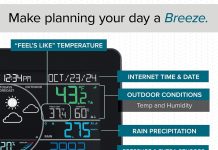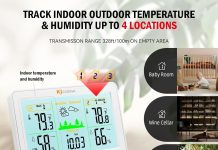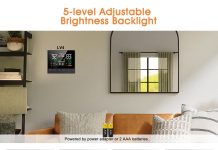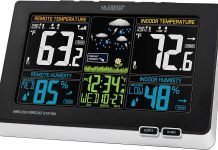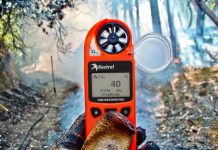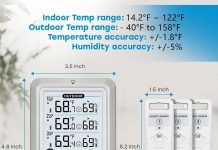In this article, we explore the possibility of connecting multiple remote sensors to a home weather station. Many of us are fascinated by the weather and want to have accurate and comprehensive data about the conditions in our immediate surroundings. With the advancements in technology, it is now possible to extend the capabilities of your weather station by connecting additional remote sensors. This opens up a world of opportunities to monitor various aspects of the weather in different locations around your home. So, let’s find out how you can expand the capabilities of your home weather station and take your weather monitoring to the next level!
Review contents
Can I Connect Multiple Remote Sensors To My Home Weather Station?
Understanding the Limitations of Your Home Weather Station
When it comes to monitoring the weather conditions in and around your home, a home weather station is an invaluable tool. However, most standard home weather stations come with limited built-in sensors, which may not cover every area or aspect you want to monitor. This is where the option of connecting multiple remote sensors to your home weather station becomes relevant.
Exploring the Benefits of Connecting Multiple Remote Sensors
By connecting multiple remote sensors to your home weather station, you can greatly expand the scope of data you collect and enhance your understanding of weather patterns in your area. These sensors can be strategically placed in different locations around your property to provide more accurate and comprehensive information about temperature, humidity, wind speed, rainfall, and more. With this enhanced data, you can make more informed decisions about outdoor activities, gardening, and even home maintenance.
Compatible Sensors for Your Home Weather Station
Before you start connecting remote sensors, it is important to ensure that they are compatible with your home weather station. Different weather station models may have different compatibility requirements, so it is crucial to refer to the user manual or manufacturer’s guidelines to determine which sensors are compatible. Common remote sensors you can connect to your home weather station include additional temperature sensors, anemometers (wind speed sensors), rain gauges, and soil moisture sensors.
Determining the Number of Sensors You Can Connect
The number of sensors you can connect to your home weather station largely depends on the specific model you own. Some weather stations have a limited capacity, allowing you to connect only a few additional sensors. On the other hand, more advanced models may have the capability to connect a larger number of sensors. It is essential to check the specifications of your weather station to know the maximum number of remote sensors it can accommodate. This ensures that you do not exceed the device’s capacity.
Factors to Consider Before Connecting Multiple Remote Sensors
Before you start connecting multiple remote sensors to your home weather station, there are a few factors you should consider. First, assess the area you want to monitor and identify the specific weather parameters you are interested in tracking. This will help you determine the type and number of sensors you need. Additionally, ensure that your weather station’s receiver is located in a central and accessible spot, as this will optimize the wireless connectivity between the sensors and the station. Lastly, consider the range of the sensors to ensure they can communicate with the weather station without any obstacles or interference.
Ensuring Proper Placement of Remote Sensors
Once you have determined the type and number of sensors you need, it is crucial to ensure their proper placement. The accuracy and reliability of the data collected depend on the correct placement of these sensors. For temperature sensors, they should be placed in shaded areas away from direct sunlight and any heat sources. Anemometers should be mounted in an open area without obstructions to accurately measure wind speed. Rain gauges need to be positioned in an open space that allows rainfall to be collected without being affected by nearby buildings or trees. Soil moisture sensors should be placed in representative areas of your garden or lawn to monitor the moisture conditions effectively.
Connecting Remote Sensors to Your Home Weather Station
Connecting remote sensors to your home weather station can be a straightforward process, but it is essential to follow the manufacturer’s instructions carefully. Typically, each sensor will have a unique channel or identifier that needs to be paired with the corresponding receiver on the weather station. This wireless connection allows the sensors to transmit data to the weather station for monitoring and analysis. Once the pairing is complete, the weather station will display the readings from all the connected sensors, providing you with a comprehensive view of the weather conditions.
Wireless Connectivity Options for Remote Sensors
There are two common wireless connectivity options for remote sensors: radio frequency (RF) and Wi-Fi. RF sensors rely on a dedicated frequency to transmit data to the weather station’s receiver. This wireless technology is reliable and has a decent range, making it suitable for most home weather station setups. On the other hand, Wi-Fi-enabled sensors connect to your home’s Wi-Fi network, allowing you to access the data directly from your smartphone or computer. This option offers greater convenience and flexibility, but it may have limitations depending on the distance between the sensors and the Wi-Fi router.
Potential Challenges and Troubleshooting Tips
While connecting multiple remote sensors to your home weather station is generally a seamless process, there may be occasional challenges. One common issue is interference from other electronic devices or nearby structures that can disrupt the wireless signals. To mitigate this, ensure that the sensors and the weather station are at an optimal distance from any potential sources of interference. Additionally, regularly check the battery levels of the remote sensors to ensure they are properly powered. If you encounter any difficulties with connectivity or data transmission, consult your weather station’s user manual or contact the manufacturer for troubleshooting assistance.
Enhancing Your Weather Data Collection and Analysis
By connecting multiple remote sensors to your home weather station, you can significantly enhance your weather data collection and analysis capabilities. The additional sensors provide a more comprehensive picture of the weather conditions in various areas of your property, allowing you to make more informed decisions about outdoor activities, gardening, and home maintenance. With accurate and up-to-date weather data, you can better plan your daily activities and ensure the well-being of your plants, animals, and property. So, go ahead and explore the possibilities of connecting multiple remote sensors to maximize the benefits of your home weather station!


